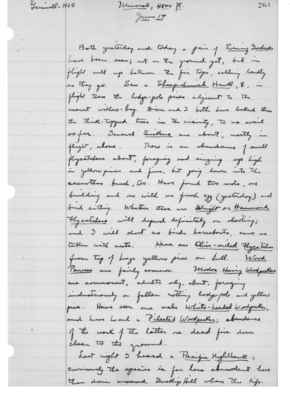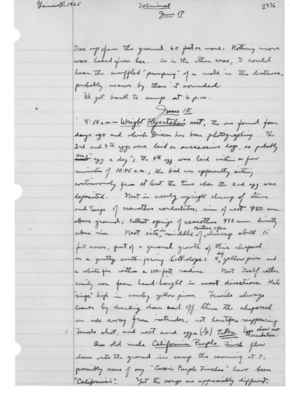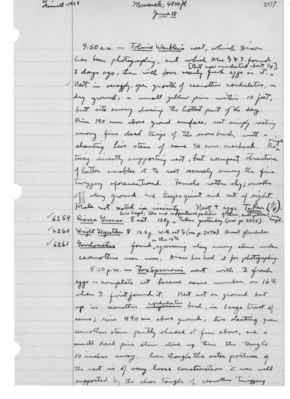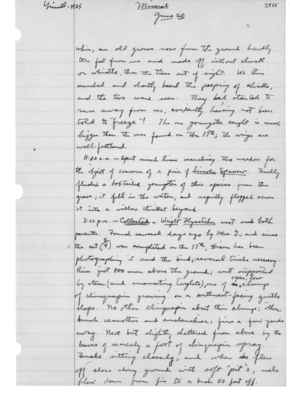Pages That Mention Wright Flycatcher
1925: Joseph Grinnell's field notes
S2 Page 7
Collector: Grinnell - 1925 Location: Lassen Section (Mineral) Date: June 14, 1925 Page Number: 2463
Both yesterday and today a pair of Evening Grosbeaks have been seen; not on the ground yet, but in flight well up between the fir tops, calling loudly as they go. Saw a Sharp-shinned Hawk, female, in flight thru the lodge-pole pines adjacent to the nearest willow-bog. Dixon and I both have looked thru the thick-topped trees in the vicinity, to no avail so far. Several Siskins are about, mostly in flight, above. There is an abundance of small flycatchers about, foraging and singing up high in yellow pines and firs, but going down into the ceanothus bush, too. Have found two nests, one building and one with one fresh egg (yesterday) and bird sitting. Whether these are Wright or Hammond Flycatchers will depend definitely on shooting; and I will shoot no birds hereabouts, save any (?) taken with nests. Hear one Olive-sided Flycatcher from top of huge yellow pine on hill. Wood Pewees are fairly common. Modoc Hairy Woodpeckers are commonest, adults only, about, foraging industriously on fallen rotting lodge-pole and yellow pine. Have seen one male White-headed Woodpecker, and have heard a Pileated Woodpecker; abundance of the work of the latter on dead firs down clean to the ground. Last night I heard a Pacific Nighthawk; curiously this species is far less abundant here than down around Inskip Hill where the life-
S2 Page 21
Collector: Grinnell-1925 Location: Mineral Date: June 17 Page Number: 2476
tree up from the ground 60 feet or more. Nothing more was heard from her. As in the other case, I could hear the muffled "pumping" of a mile in the distance, probably nearer than it sounded.
We got back to camp at 6pm.
8:15 a.m -- Wright Flycatcher's nest, the one found four days ago and which Dixon has been photographing. The 3rd and 4th eggs were laid on successive lays, so probably an "egg a day"; the 4th egg was laid within a few minutes of 10:45 a.m.; the bird was apparently sitting continuously from at least the time when the 2nd egg was deposited. Nest in nearly upright clump of stems and twigs of Ceanothus cordulatus; rim of nest 950 mm. above ground; tallest sprigs of ceanothus 490 mm. directly above rim. Nest site in middle of rather open clump about 15 feet across, part of a general growth of this chaparral on a gently south-facing hill-slope; 4 big yellow pines and a white fir within a 100-foot radius. Nest itself rather easily seen from head-height in most directions. Male "sings" high in nearby yellow pines. Female always leaves by ducking down and off thru the chaparral on side away from intruder, not heretofore reappearing. Female shot, and nest and eggs (1/4) taken. Eggs show no incubation.
One old male California Purple Finch flew down onto the ground in camp this morning at 7; possibly some of my "Cassins Purple Finches" have been "California's". Yet the songs are appreciably different.
S2 Page 22
Collector: Grinnell-1925 Location: Mineral, 4800 ft. Date: June 18, 1925 Page Number: 2477
9:50 am -- Tolmie Warbler's nest, which Dixon has been photographing, and which Mrs. G & I found 3 days ago, then with four nearly fresh eggs in it. ^[But now incubated about 1/4.] Nest in scraggly, open growth of ceanothus cordulatus, in dry ground, a small yellow pine within 10 feet, but site sunny during the hottest part of the day. Rim 190 mm. above ground surface, nest snugly resting among five dead twigs of the snow birch, with a slanting live stem of same 80 mm. overhead. No single twig directly supporting nest, but compact structure of latter enables it to rest securely among the fine twiggery aforementioned. Female rather shy; sneaks off along ground and keeps quiet and out of sight. Male not noted in vicinity. Nest & eggs taken (1/4). 6259 Sierra Grouse (male) nat. 13.8g. ^Iris hazel; toes and unfeathered portions of tarsi, dull yellow; iris hazel. Taken yesterday (see p. 2475). 6260 Wright Flycatcher (female) 12.2g. With set 1/4 (see p. 2476). Breast glandular. 6261 Gerrhonotus found ^on the 16th squirming along among stems under ceanothus near mom; Dixon has had it for photographing. 5:10 p.m. -- Fox Sparrow's nest with 3 fresh eggs -- complete set because same number on 16th when I first found it. Nest not on ground but up in ceanothus integerrimus cordulatus bush, in large tract of same; rim 490 mm. above ground; two slanting green ceanothus stems partly shaded it from above, and a small dead pine stem stood up thru the tangle 10 inches away. Even though the outer portion of the nest is of very loose construction it was well supported by the close tangle of ceanothus twiggery
S2 Page 25
Author: Grinnell-1925 Location: Mineral, 4800 ft. Date: June 19 Page Number: 2480
Later: found the Traill Flycatcher's nest some 7 feet up in a crotch of slender willow stem in the midst of an isolated willow clump in the meadow - just in process of construction. In a tract of old lodge pole pines a little farther along, a crowd of birds was distraught over something, tho I failed to find what the threatening danger was. The crowd included: Juncos, a pair of Robins, a Lincoln Sparrow, a Pigmy Nuthatch (the first I have seen in the Lassen "section"), a Hammond (or Wright) Flycatcher, several Chipping Sparrows, and a pair of Audubon Warblers. Nearby was a (female) White-headed Woodpecker.
As to mammals: winter earthcores of Thomomys monticola occur in places where the ground is well-drained at the sides of meadows but not out in them. The common chipmunk is Eutamias amoenus, about logs overgrown with snowbushes, but they are very quiet now; two visit camp, but so far are shy. A (female) Eutamias senex was trapped in a neighbor's camp yesterday morning at 5 o'clock. Last evening just before sundown, Dixon shot an old male jack-rabbit (Lepus c. californicus) in a tract of sparse snowbush. Mrs. G. has seen another partly grown one in the same vicinity. This must be the extreme easternmost limit of this subspecies in the "section". Also, Mrs. G. and Dixon have both seen individuals of the snow-shoe rabbit (Lepus w. klamathensis).
S2 Page 30
Collector: Grinnell-1925 Location: Mineral Date: June 20 Page Number: 2485
whir, an old grouse rose from the ground hardly ten feet from us and made off without cluck or whistle, thru the trees out of sight. We then marched and shortly heard the peeping of chicks, and the two were seen. They had started to run away from us, evidently having not been told to "freeze"! The one youngster caught is much bigger than the ones found on the 17th; the wings are well-feathered.
11:30 a.m. - Spent much time searching the meadow for the object of concern of a pair of Lincoln Sparrow. Finally flushed a bobtailed youngster of this species from the grass; it fell in the water, and rapidly flopped across it into a willow thicket beyond.
3:00 p.m. - Collected a Wright Flycatcher nest and both parents. Found several days ago by Mrs. G, and since the set (2/4) was completed on the 17th, Dixon has been photographing it and the bird; several trials necessary. Rim just 800 mm. above the ground; nest supported by stem (and innovating twiglets), one of an ^open, low clump of chinquapin growing on a southwest-facing gentle slope. No other chinquapin about this clump; other brush ceanothus and amelanchier; firs a few yards away. Nest but slightly sheltered from above by the leaves of scarcely a foot of chinquapin spray. Female sitting closely, and when she flew off close along ground with soft "pit"s, male flew down from fir to a bush 50 feet off.




